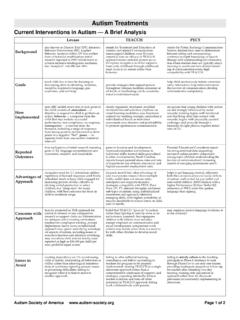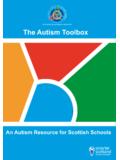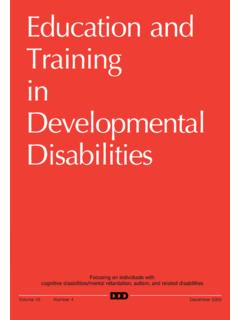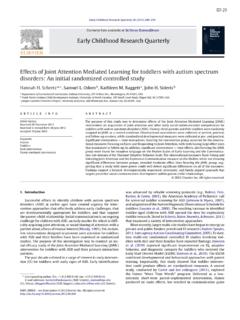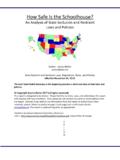Transcription of Autism Services in Connecticut
1 Autism Services in Connecticut A report from the Autism Feasibility Study Workgroup Recommendations to Enhance and Improve the Service System to Support Individuals with Autism and their Families January 2013 Table of Contents Contents Understanding Autism _____ 1 What is Connecticut Doing for Individuals with Autism ? _____ 2 Prevalence of Autism _____ 4 Effective Services _____ 6 Utilization Data _____ 9 Gaps in the Connecticut Autism Service System _____ 16 Recommendations _____ 19 Implementation Timeline _____ 23 Understanding Autism Understanding Autism Autism Spectrum Disorder (ASD) is a developmental condition caused by neurological dysfunction that is yet to be well understood. ASD is more common in males than females and there are genetic factors that contribute to its prevalence. ASD is defined by three central areas of challenge: social interaction, communication and involvement with restricted interests and repetitive activities.
2 In most cases, there are also difficulties with sensory processing, creativity/imagination and learning. Autism is a spectrum disorder because there is wide variation in its severity. Some individuals present severe cognitive challenges and are unable to speak or respond to people. Also, within the Autism spectrum, there are individuals who are intellectually gifted who are able to succeed in school with minimal supports. Many individuals with ASD also experience other behavioral health and medical conditions, further complicating their course of treatment. There is no cure for Autism , but individuals can improve their functioning through behavioral and developmental treatments, specialized educational programming, social skills interventions, speech therapy and adaptive skills training. The approach to helping individuals with ASD is somewhat different than traditional clinical and educational practice; research has identified a group of evidence-based practices that are effective in facilitating the development of people with ASD.
3 The importance of effective Services cannot be overstated, particularly early intervention Services . With appropriate programming, many individuals with ASD can lead independent lives as adults, working and participating in community life. Without effective Services , individuals with ASD are much less likely to live independently, become productively employed, or establish social relationships. Without effective Services , individuals with ASD are much less likely to live independently, become productively employed, or establish social relationships. What is Connecticut Doing for Individuals with Autism ? What is Connecticut Doing for Individuals with Autism ? Connecticut does not have a comprehensive or coordinated service system to address the needs of individuals with Autism or their families. Services are available through individual school districts, small programs in state agencies and private practitioners, but these are inconsistent in approach and quality and do not meet the level of need.
4 Consequently, Section 27 of Public Act 11-6 required a study of issues related to the needs of persons with ASD, including the feasibility of a Center for Autism and Developmental Disabilities. This study was begun in May 2011 led by the Department of Social Services (DSS) and included the Departments of Developmental Services (DDS), Mental Health and Addiction Services (DMHAS), Education (SDE), Children and Families (DCF) and the Office of Policy and Management (OPM). ValueOptions, the administrative Services organization (ASO) for the Connecticut Behavioral Health Partnership (CT BHP), provided assistance with literature reviews, data analysis and summary documentation of the activities and findings of the ASD Workgroup Committee. Besides the state agency representatives, a larger workgroup, the Autism Feasibility Study workgroup was formed, including providers, academics, advocates, and consumer representatives.
5 Over the past year, the workgroup examined the following issues: Prevalence of Autism Spectrum Disorder in Connecticut A focused literature review of the behavioral treatment of ASD focusing on evidence-based or promising treatments available for this population Utilization of state funded or provided Services by the ASD population Identification of service gaps based on utilization data as well as input from professionals, advocates, families, and state agencies Current Services for ASD in Connecticut are inconsistent in approach and quality and do not meet the level of need. What is Connecticut Doing for Individuals with Autism ? Recommendations for system changes necessary to enable Connecticut residents with ASD to access effective Services . The pages that follow represent the findings and recommendations of the ASD Feasibility Workgroup.
6 The Workgroup developed their recommendations based on the simple principle that all individuals with an Autism Spectrum Disorder (ASD) should receive effective clinical and support Services that are person-centered, culturally competent and provided by qualified professionals. This report represents a summary of a larger report that is available to those interested in a more in depth review of the each section that follows. All individuals with an Autism Spectrum Disorder (ASD) should receive effective clinical and support Services that are person-centered, culturally competent and provided by qualified professionals. Prevalence of Autism Prevalence of Autism According to the most recent study from the Centers for Disease Control (CDC; March 2012), the estimated prevalence of Autism in eight-year-olds is 1 in 88 ( ) and 1 in 54 boys ( ).
7 This represents a 23% increase since the CDC s last report in 2009. There are numerous reasons for this increase, including, but not limited to, an actual increase in the number of individuals with the disorder, improved access to evaluation Services , a greater public awareness of the disorder leading to less stigma, and more professionals with specialty of evaluating the disorder. It is likely that these numbers do not include undiagnosed adults because of the lack of knowledge regarding ASD during their youth and adolescent years. Connecticut s Status Update Data was collected and reviewed from state agencies that serve individuals with ASD in order to compare the national prevalence estimates and the estimated prevalence rates in Connecticut for those receiving Services through the state agencies. State Agency Estimated Prevalence Rate* Age Year State Department of Education of total CT youth who receive special education service in the Autism category** K-12 2010 Department of Children and Families of youth being treated in community based behavioral health Services funded by DCF 0-18 2010 The CDC estimated prevalence of Autism in eight-year-olds is: 1 in 88 ( ) and 1 in 54 boys ( ) Prevalence of Autism State Agency Estimated Prevalence Rate* Age Year Medicaid HUSKY A and B 0-18 2010 Department of Developmental Services : Birth to Three Program 0-2 Children born in 2007 * It should be noted that state agencies do not necessarily define Autism the same way.
8 For example, the State Department of Education data cited above references the educational classification of Autism , not the medical diagnosis. **The State Department of Education (SDE) prevalence rate is likely an underestimate; many youth with ASD are included in other SDE special education categories. Using the prevalence rate and the 2011 United States Census estimates for the number of youth 18 years or younger, the estimated number of Connecticut youth with ASD is approximately 9,143 (based on US Census Bureau, 2011 count of 802,079 youth in CT <18 years old). Because ASD is not considered curable, it is also assumed that the number of Connecticut residents with ASD across the age span is approximately 40,820 (based on US Census Bureau, 2011 count of 3,580,709 people in CT). The estimated number of Connecticut residents with ASD across the age span is approximately 40,820.
9 Effective Services Effective Services Background There has been a tremendous amount of research published in peer-reviewed journals on the effectiveness of various interventions for people with Autism Spectrum Disorder (ASD). Two national organizations performed systematic literature searches to determine what best practices exist for the treatment of Autism . In 2008, The National Professional Development Center (NPDC, 2009) on Autism Spectrum Disorders identified 24 interventions that met their criteria for evidence-based practices for children with ASD. The National Autism Center (NAC, 2009) also completed a comprehensive, multi-year review of the literature on Autism interventions entitled The National Standards Project . The intention was to identify the scope of research available for interventions for children and adolescents with ASD.
10 Evidence based practices are applied to a wide range of programming addressing both instruction and changing maladaptive behaviors. This includes academic teaching in school, behavioral treatment, vocational and life skills coaching, speech therapy, and social skills training. These two research projects determined that there are a number of interventions for individuals with ASD that have evidence supporting their effectiveness. Examples of evidence-based interventions include behavioral interventions such as Applied Behavior Analysis (ABA), Early Intensive Behavioral Intervention, and Comprehensive Behavioral Treatment for Young Children. Applied Behavioral Analysis (ABA) is the most well-known and best-researched intervention for children with ASD. ABA is considered to be both an established intervention and an evidence-based practice by both national organizations.










